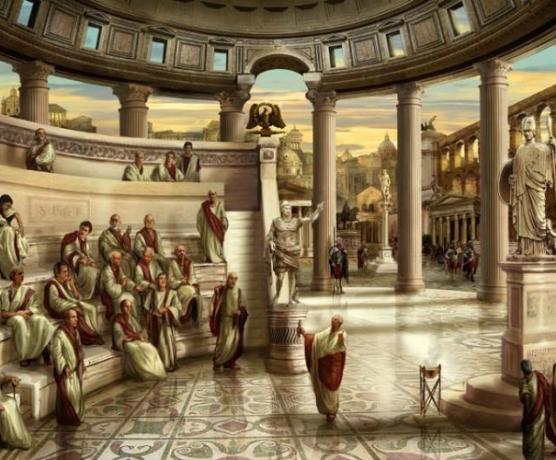The Roman Empire lasted from 27 a. Ç. – 476 d. Ç. During this period, power was exercised by the emperors. There was also the senate, provincial governors and generals.
The first centuries of the Roman Empire were marked by a prosperous and stable phase in terms of political context. At its height, the Empire reached five million square kilometers and represented 21% of the world's population.
Get to know now 7 important features of this period:
1. Senators held a lifetime position

In Rome, senators were chosen taking into account the wealth and social status occupied by citizens. They belonged to a social layer called patricia and were the owners of agricultural production properties.
Initially, the selection process for these positions took place among citizens who were part of the nobility. However, in other periods it also included the social strata of commoners.
During the Empire, senators always represented the highest rank of the Roman State.
2. The Roman Empire was polytheistic
Polytheism consists of a belief that contemplates the worship of different deities and the Romans' belief included elements that belonged to different types of cults.
The polytheism of the Roman Empire was mainly influenced by Greek, Etruscan and Oriental beliefs.
The period of decline of polytheistic belief in the Roman Empire was due to the rise of Christianity between the 1st and 4th centuries, which later became the official religion of the Empire.
See also the meaning of Polytheism.
3. Military coups were one of the forms of conquest

The coming to power and obtaining new territories for the Empire often happened through coups d'état and advances made with the help of the Roman army.
An example was the conquest carried out by Emperor Julius Caesar (100 BC). C - 44 a. C), who invaded the city of Rome under the protection of the army, assuming power in a dictatorial way.
The army also had the function of protect territories already conquered through military coups.
4. The economy was based on agriculture and mining
The economy of the Roman Empire was mostly based on agriculture, a sector that employed most of the common workers.
The Romans were responsible for improving harvesting processes by incorporating a method of irrigation made through aqueducts. It is also believed that, in addition to using animals to till the land, the Romans resorted to mechanized resources.
Another important activity for the economy of the Roman Empire was mining, mining explorations included open-pit and underground mines.
The main ores handled during the period were lead, copper, tin, iron, gold and silver.
5. Had great impact in the domain of architecture

Roman architecture is well known for its numerous temples, courts, palaces, arches and public baths, having importance in world architecture to this day. It was influenced by Greek architecture and its architectural orders (Doric, Ionian and Corinthian).
The aqueducts are a highlight of Greek architecture. Water supply systems that were created to irrigate cities are refined.
Roman architecture is essentially characterized by its grandiose works, the use of columns and arches and a strong presence of wealth and luxury in the buildings.
Examples of some of the most famous works of Roman architecture, located in the city of Rome: Coliseum, Roman Forum and Pantheon.
Roman architecture directly influenced other architectural styles, such as Renaissance architecture.
Also read about the greek architecture.
6. Emergence of Latin
Latin emerged during the Roman Empire, being initially spoken in Lazio, the Italian region where the city of Rome was founded. It was the official language of the Roman Empire during its existence.
Over time, it spread to the rest of the Italian territory and to other parts of the European continent.
It was popular Latin, used by Roman citizens, that reached other regions. Besides this, there was also erudite Latin, which was used by writers and by the most literate citizens of the time.
The Latin language has great importance in world history because gave rise to several other languages, called Latin languages, such as Italian, Portuguese, Spanish and Galician.
7. Creation of Roman Law

During the period of the Roman Empire, rules were created that influence the Law until the present day. Such rules began to be used at the beginning of the foundation of Rome, which took place in the year 753 BC. Ç.
At that time there was a complex legal system that was initially based on the customs of the local society. It is also from the period of the Roman Empire that the concept of citizenship emerged, which is so important for the functioning of the legal universe to this day.
The principle of legislation during the Roman Empire is marked with the Law of the Twelve Tables, which established norms corresponding to a Constitution. This law also defined some rules of behavior and social life.
The Twelve Tables Law dealt with matters that are still protected by Law, such as: property rights, successions, crimes and matters of Public Law.
Also read the meanings of Roman Empire, Empire and citizenship.


